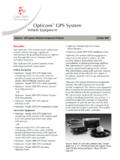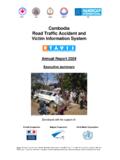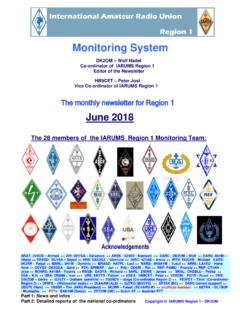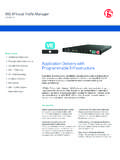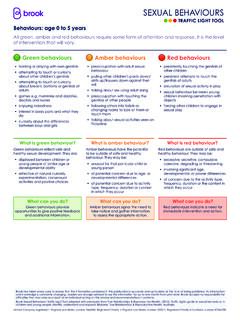Transcription of Standard Measuring Equipment - helidecks
1 Standard Helideck monitoring Systems Rev 8c 2012 07 Page 1 of 12 Standard Measuring Equipment for Helideck monitoring system (HMS) and Weather Data (HCA, Bristow Group, Bond Offshore, CHC) Standard Helideck monitoring Systems Rev 8c 2012 07 Page 2 of 12 Contents 1 Purpose and intentions .. 3 2 Definitions .. 3 3 Classification of helidecks .. 3 4 Operational Limitations .. 4 5 Principles .. 5 6 Accuracy of measurements .. 5 Maximum Pitch .. 6 Maximum Roll .. 6 Maximum Helideck Inclination .. 6 Maximum Heave (Vertical Movement) .. 6 Heave Period .. 6 Maximum Average Heave Rate .. 6 Traffic light on display .. 7 7 Heading of Helideck/Vessel .. 7 8 Weather data .. 7 Wind Direction .. 7 Wind Speed .. 7 Visibility .. 7 Temperature/Dewpoint.
2 7 Air Pressure .. 7 Cloud .. 8 Logging system .. 8 9 Future system Upgrades .. 8 Motion Severity Index (MSI) .. 8 Wind Severity Index (WSI) .. 8 Helicopter Operating Limits .. 8 10 Attachment 1: Helideck Movement and Weather data display .. 10 11 Attachment 2: Logistics Information display .. 11 12 List of known motion measurement Equipment producers .. 12 Standard Helideck monitoring Systems Rev 8c 2012 07 Page 3 of 12 1 Purpose and intentions The purpose of this document is to ensure uniformity of readings/registration of helideck movement and weather conditions. This Standard is an agreement between Bristow Group (Bristow Norway and Bristow UK), Bond Offshore Helicopters and CHC (CHC Norway and CHC UK), and shall apply to all Moving helidecks operating on the UK and Norwegian Continental Shelves.
3 Further intentions are to establish National and International standards based on contents of this document. 2 Definitions Moving helidecks : A helideck mounted on a floating unit such as a Vessel, Floating Production Unit, Semi Submersible Rig or floating Jack Up Rig and other helidecks shall be considered to be an unstable/moving landing area if the pitch or roll exceeds 1 degree either side of the vertical and if the vertical movement of the helideck exceeds 2 metres. Helideck Inclination: is the angle between the absolute horizon and the plane of the helideck. Average heave rate: is the average speed of the helideck between the top and the bottom of a wave movement curve. Maximum average heave rate: is the average heave rate of the largest wave (peak value) within a 20 minute time frame in metres per second.
4 3 Classification of helidecks There is no official classification method available for this purpose. The proposed classification contains three categories based on the actual floating unit s size, configuration and motion characteristics. It simplifies the current Helideck Certification Agency classification and is based on the current Norwegian classification. Limitations are defined by helideck pitch, roll and inclination and by helideck heave rate. A prime requirement is that the installations have Measuring and monitoring Equipment installed, and functional, in accordance with this document. Those installations which would normally fall into Category 1 or 2, but which either do not have the appropriate Measuring or monitoring Equipment installed, or whose Equipment is inoperative, are automatically downgraded by one category ( a Category 1 deck with inoperative Equipment becomes a Category 2 deck).
5 The category will be entered on the individual vessel/rig information plate in the North Sea Airway Manual or rig plate and the Company Helideck Limitation List (HLL). Standard Helideck monitoring Systems Rev 8c 2012 07 Page 4 of 12 Category 1: Semi-submersibles including floating jack ups and all large vessels including FPSOs and tankers. This category combines the existing HCA codes B and C and the Norwegian code A+. Category 2: Small vessels, DSVs and seismic vessels, with a helideck that offers good visual cues. This would normally be a stern or midships deck offering a view of the structure of the vessel through at least 90 (assuming the vessel is steaming more or less into wind). This category combines the existing HCA code E and the Norwegian codes B+ and A. Category 3: Small vessels with poor visual cues, such as a bow deck or a deck mounted above the bridge superstructure with the landing direction facing forwards (bow deck) or abeam (high deck).
6 This category combines the existing HCA code D and the Norwegian code B. NOTE: Small vessels will be categorized 2 or 3 on inspection by the HCA and their helideck certificate and associated Jeppesen or EAG data will reflect this (except that small vessels with midships decks will always be Category 2). In addition, aircraft are divided into two types heavy and medium. The heavy types are the AS332 series, EC225, SK61 and SK92. The medium types are the SA365N/AS365N2/N3, EC155, S76 series, B214ST and AW139. Note that this does not constitute a helideck approval for a specific helicopter type on a specific helideck. 4 Operational Limitations The proposed classification is defined in the table. AIRCRAFT HELIDECK CATEGORY CATEGORY 1 2 3 P/R INC H/R H/A P/R INC H/R H/A P/R INC H/R H/AHEAVY DAY 3 2 2 NT 3 2 1 MEDIUM DAY 4 3 3 NT 4 2 Key: P/R = Pitch and Roll (deg); INC = Helideck inclination (deg); H/R = Heave Rate (m/s); H/A = Heave Amplitude (metres) peak to trough distance.
7 For tanker mooring buoys the pitch and roll limits remain 2 by day and 1 by night ( Category 3 heavy). NOTE: Although both heave rate and amplitude figures are given, heave rate shall be used where available. The use of heave amplitude will be discontinued once helideck monitoring systems are updated to the latest Standard . Standard Helideck monitoring Systems Rev 8c 2012 07 Page 5 of 12 5 Principles Basic reference is made to: Norwegian Requirements in BSL D UK guidelines in CAP 437 Reference is also made to: Sintef Report 22D114,199-11-09 FPSO Helideck Motion Criteria The Measuring Equipment shall provide sufficient information to the operator to complete all sections of the Standard Rig Report, provided for by the helicopter operators. Measuring Equipment sensors for helideck movement, wind and weather data shall be located in optimum positions in order to provide relevant information relating to the helideck.
8 All information shall be numerically displayed in relevant locations on the vessel or rig for easy communication with helicopters in flight and the helicopter land base operations. The system shall facilitate transmittal of electronic data to the helicopter land base operation, which in turn can eliminate the need for a separate Rig Report to be submitted. 6 Accuracy of measurements The monitoring system (sensors and data programs) shall be checked and verified for correctness on the system field location, strictly in accordance with the manufacturer s procedures. A verification report showing the correctness of the system shall be provided to both the owner of the installation and to the helicopter operators, after first installation.
9 The accuracy of the system shall be checked and verified whenever deemed necessary, but at least once every 3 years. A verification report shall be issued and distributed as described above, after each periodic control. The dynamic accuracy of the data produced by the Helideck monitoring system concerning motion shall be: Pitch / Roll / Inclination: < RMS (Root Mean Square) in the range 0 to 3,5 and Heave Rate: < m/s RMS (Root Mean Square) in the range 0 to m/s The accuracy concerning the meteorological data shall be in compliance with NORSOK N-002 Collection of Metocean Data and NORSOK C-004 Helicopter deck on offshore installations Standard Helideck monitoring Systems Rev 8c 2012 07 Page 6 of 12 Measuring helideck motion See paragraph 9 for Motion Severity Index calculation Maximum Pitch The Equipment shall be capable of Measuring helideck pitch in degrees up and down from zero, with zero being the absolute horizontal level.
10 It shall be possible to read the historic maximum angles over the past 20 minutes, direct and, if possible, graphically. The graphical presentation shall cover 20 minutes of data and alternatively 3 hours for trend determination. The graph and the associated maximum value over the last 20 minutes shall be updated at least at 1 minute intervals. In maritime terms maximum pitch consists of trim + pitch. Maximum Roll The Equipment shall be capable of Measuring helideck roll in degrees right/starboard and left/port, with zero being the absolute horizontal level. It shall be possible to read the historic maximum angles over the past 20 minutes, direct and, if possible, graphically. In maritime terms maximum roll consists of list + roll. Maximum Helideck Inclination The Equipment shall be capable of Measuring the maximum helideck inclination in degrees to the absolute horizon over the past 20 minutes, direct and, if possible, graphically.





